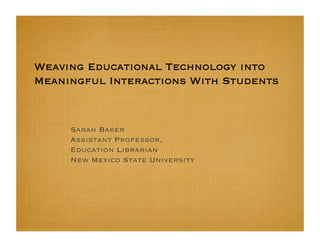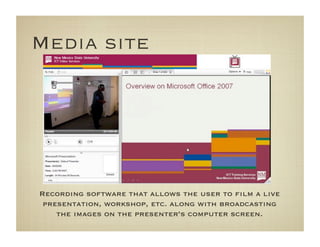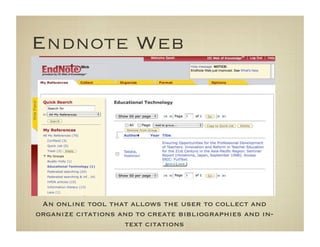Educational Technology Tools
- 1. Weaving Educational Technology into Meaningful Interactions With Students Sarah Baker Assistant Professor, Education Librarian New Mexico State University
- 2. Educational technology tools Presentation Software Screen Capture Software Podcasting/ Vodcasting Video conferencing/ chat Research tools Course management software Second life
- 3. Presentation Software MediaSite Voice thread http://voicethread.com/#home Free site to publish presentations online: SlideShare http://www.slideshare.net/
- 4. Media site Recording software that allows the user to film a live presentation, workshop, etc. along with broadcasting the images on the presenter’s computer screen.
- 5. Voice thread Free software that allows the user to create multimedia presentations such as adding a voice-over to Power Point presentations, etc. other features include being able to share the presentation and allowing multiple users to add comments.
- 6. Screen Capture Software Screencast-o-matic http://www.screencast-o-matic.com/ Captivate (adobe) Camtasia http://lib.nmsu.edu/staff/twestbrock/videos/LibraryCatalog/LibraryCatalog_skin.swf
- 7. Screencast-o-matic Free screencast software allowing the user to create basic tutorials with optional audio commentary. You can export the video as a movie file (flash, quicktime, windows media etc.) or upload it directly to YouTube or Screencast-o-Matic to host.
- 8. audio editing audacity http://audacity.sourceforge.net/
- 9. Audacity Free audio editing software for use with creating podcasts, etc.
- 10. Video sites/ Podcasting/ vodcasting Youtube (select youtube edu education channel) http://www.youtube.com Veezyon www.veezyon.com Itunes u
- 11. Veezyon Free educational/ professional videos created collaboratively with universities and organizations in five general content areas: Health & Medicine, Science & Technology, Art & Music, Public Affairs, and Business.
- 12. Video Conferencing/ chat Skype (mac or pc)- Free video conferencing and chat tool that is available internationally. http://www.skype.com/ Ichat (mac) Meebo http://www.meebo.com/
- 13. Meebo Free instant messaging tool that works across platforms such as AIM, Yahoo, MSN, etc.
- 14. Research tools libguides (subject/ course guides) http://libguides.com/ Google Books/ WorldCat http://books.google.com/ Google scholar http://scholar.google.com/ Vendor databases Federated search tools (serials solutions 360)
- 15. LibGuides Software for creating subject/ course guides and sharing them with a community of libraries.
- 16. Federated Search A tool that allows the user to search simultaneously across multiple databases and the library catalog.
- 17. Citation Management Software/ Social Bookmarking Endnote Web https://www.myendnoteweb.com Refworks Delicious (social bookmarking) http://delicious.com/
- 18. Endnote Web An online tool that allows the user to collect and organize citations and to create bibliographies and in- text citations
- 19. Delicious Free social bookmarking tool that allows the user to collect and share bookmarks to online resources. It also allows you to tag/ categorize your bookmarks.
- 21. Blackboard/ webct Software that allows educators to build courses, training modules, etc.
- 22. Second Life A 3-D, virtual world where educators can post multi- media presentations, create simulations, develop 3-D learning objects, and much more.
- 23. Resources Voice Thread- http://voicethread.com/#home SlideShare- http://www.slideshare.net/ Veezyon- www.veezyon.com Audacity- http://audacity.sourceforge.net/ Skype- www.skype.com Meebo- http://www.meebo.com/ Delicious- http://delicious.com/ Screencast-o-Matic - http://www.screencast-o-matic.com/ Moodle- http://moodle.org/ Second life- http://secondlife.com/






















